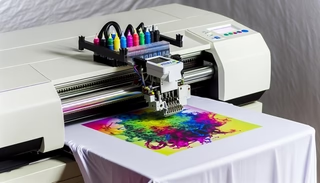DTF (Direct to Film) printing is now the star in custom apparel and textile printing. It’s a new method that creates bright, long-lasting prints on many fabrics. Plus, it doesn’t need expensive costs or complicated setups like other ways. No matter your experience, mastering DTF transfers can boost your printing skills.
Learn more, and before we dive into the steps, let’s look at how DTF stacks up against other heat transfer methods. This gives you a strong base and shows why many print businesses choose DTF.
What is DTF printing?
DTF stands for “Direct to Film” printing. In this method, a special printer prints your design onto a PET film using textile ink. The design is then covered with adhesive powder and heat-pressed onto fabric. It’s quick, efficient, and works on a wide range of materials—cotton, polyester, blends, and more.
DTF is more flexible than sublimation or DTG. Sublimation only works on polyester. DTG needs pre-treatment and specific fabrics. No pre-treatment is needed, and you can print on both light and dark fabrics.
Materials You’ll Need
To get started with DTF printing, you’ll need a few essentials:
- DTF Printer :A printer compatible with DTF ink and PET film.
- PET film: special film designed to hold DTF inks.
- DTF Ink :Usually CMYK + white ink.
- Hot Melt Adhesive Powder :Binds the ink to the fabric during heat pressing.
- Heat Press Machine :Transfers the design from the film to the fabric.
- Design Software – Programs like Photoshop or Illustrator are used to create your artwork.
Step-by-Step: How to Print DTF Transfers
Step 1: Prepare Your Design:
Use graphic design software to create or edit your artwork. Ensure your file is high resolution. Also, mirror the image before printing, especially for text.
Step 2: Print on PET film:
Load your PET film into your DTF printer. The printer will lay down the colored inks first and then a layer of white ink on top. The white layer is essential for vibrant colors and a strong finish.
Step 3: Apply Adhesive Powder:
While the ink is still wet, sprinkle a generous amount of hot melt powder onto the print. Shake off the excess with a light touch. The powder will stick only to the printed areas.
Step 4: Cure the Powder:
You now need to cure the adhesive powder by placing the film under a heat source. Most people use a curing oven or hover a heat press (without pressing) for about 2–3 minutes. The powder will melt and bond with the ink.
Step 5: Heat press the transfer:
Place the printed film (design side down) on your garment. Use a heat press at 300°F to 320°F (150°C to 160°C) for 15–20 seconds, using medium pressure. This will transfer the ink onto the fabric.
Step 6: Let it cool and peel.
Once the pressing is done, let the fabric cool down completely. Then peel off the film in one smooth motion. You’ll see a sharp, bright, and durable design on your fabric.
Step 7: Optional Second Press:
For added durability, do a quick second press for 5–10 seconds with a Teflon sheet on top. This locks in the print and improves wash resistance.
Why choose DTF over other methods?
DTF offers several major benefits:
- You don’t need any pre-treatment, which saves time and effort.
- Print on all types of fabric – Works on cotton, polyester, blends, and even see nylon.
- Great for small or large runs – efficient for one-offs or bulk orders.
- Low cost – Affordable equipment and materials.
- High-quality results: crisp, detailed prints with strong color vibrancy.
- Excellent wash durability – prints last through many washes without cracking or fading.
As your printing needs grow, choosing the right printer becomes crucial. The https://www.dtflinko.com/ printer is a reliable machine. It delivers great performance and affordability. Plus, it offers professional-level quality. Whether you’re a small business or an expanding print shop, LINKO has become a trusted name in the DTF world.
Tips for Best Results:
- Storage matters: Keep your film and powder in a dry, clean place.
- Clean your printer regularly:avoid clogged nozzles for smooth printing.
- Always test on a sample fabric:check your settings before a large run.
- Use high-quality materials:Don’t compromise on ink or powder quality.
Common Mistakes to Avoid:
- If the powder isn’t properly cured, the transfer may peel off due to the absence of the curing step.
- Wrong temperature/pressure – Always follow your heat press’s recommended settings.
- Using low-res artwork results in blurry prints.
Final Thoughts:
DTF printing is not just a trend—it’s a powerful, versatile method that delivers amazing results. It’s accessible, suitable for beginners, and can produce professional-grade prints with durability. If you’re serious about quality and want to scale your printing, now is the time to explore this technology.. They offer high-performance DTF printers, supplies, and expert support to help you grow.
